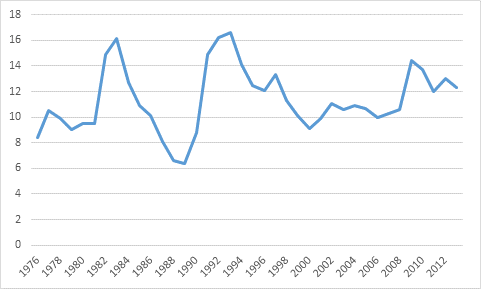Yesterday I showed that recent Ontario university graduates’ incomes are taking a beating, notably in Arts and Sciences. I’m sure this led to a fair bit of crowing among those who claim we have too many students in university, and they all oughta go to college instead because skills, new economy, yadda yadda.
The problem with that argument is that college grads are getting creamed in the labour market, too.
Now, we can’t compare university and college outcomes in terms of incomes because Colleges Ontario – unlike COU – doesn’t publish income data from the provincial graduate survey. Nor can we compare graduate employment rates over 2 years because – for reasons that pretty much defy any rational explanation – the Ontario government doesn’t track college graduates past the first six months. But at the six-month-after-graduation point, we do at least have a point of comparison between the two sectors. Let’s see how it looks:
Figure 1: Percent of Ontario Graduates Employed Six-Months Out, by Graduating Class
So, as with yesterday, let’s take this graph with a grain of salt – this is the employment rate excluding those who go on to do further study. That said, what it shows is that while both college and university graduates in Ontario took a hit in the recession, the hit was actually considerably bigger on the college side: what was a one and a half percentage-point gap in six-month-out employment rates before the recession is now almost a five percentage point gap. And that’s not simply due to good results among professional programs in universities – even Humanities grads have increased the gap.
(NB: the drop at most colleges hasn’t been quite this drastic; but, the 6-month employment rate deterioration at some of the big Toronto colleges – 9% at Sheridan and Seneca, and 13% at Centennial – throw the average off quite a bit.)
So the fall in real incomes appear to be generalized across post-secondary education rather than specific to general Arts/Science programs at universities. Why might this be? Well, first, it’s worth bearing in mind that our baseline year – 2007 – was a reasonably good year for youth employment in Ontario. Indeed: only three of the last 23 years saw lower youth unemployment rates than 2007. So comparing to 2007 means we’re starting from a high base.
Figure 2: Unemployment Rates for 20-24 Year-Olds, Ontario
And the other thing to remember is that the graduating class of 2011 was more than 10% larger than the class of 2007, because of the major expansion of access that occurred in the aughts. This will tend to move the average downward in two ways: first, through competition (more grads chasing a similar number of jobs could result in the bidding-down of labour prices); and second, through composition effects (as access increased, the likelihood is that universities were also taking-in more students of slightly lower ability, which could also push down the average wage a bit).
None of this is meant to deny that university grads in Ontario are having a bad few years; it is, however, to say that there are a number of structural factors that need to be taken into account before jumping to the conclusion that universities “aren’t worth it”.



 Tweet this post
Tweet this post

One response to “More Graduate Labour Market Data”